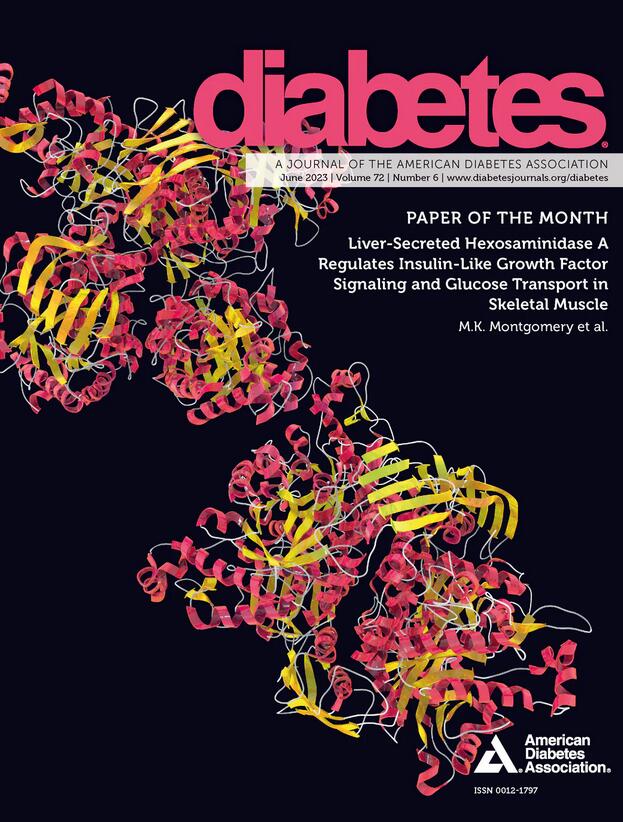346-OR: Hypothalamic Gliosis Is Associated with CVD Risk Factors in the Framingham Heart Study (FHS)
IF 6.2
1区 医学
Q1 ENDOCRINOLOGY & METABOLISM
引用次数: 0
Abstract
Introduction: Hypothalamic gliosis is linked to obesity and insulin resistance in rodent models and humans. We tested associations between a radiologic measure of hypothalamic gliosis and clinically relevant cardiovascular disease (CVD) risk factors, as well as prevalent coronary heart disease (CHD). Methods: Using brain MRI images from FHS participants (n=867), T2 signal intensities were extracted bilaterally from the region of interest in the mediobasal hypothalamus (MBH) and reference regions in amygdala (AMY) and putamen (PUT). T2 signal ratios were created in which greater values suggest gliosis. The primary measure compared MBH to AMY (MBH/AMY); a positive control ratio (MBH/PUT) also assessed MBH whereas a negative control (PUT/AMY) did not. Outcomes were BMI, HDL-C, LDL-C, triglycerides, and the presence of hypertension (HTN; n=225), diabetes mellitus (DM; n=66), or metabolic syndrome (MetS; n=254). Prevalent CHD (n=22) was adjudicated by FHS. Linear and logistic regression models included age, sex, smoking, treatment status (e.g., lipids), and BMI (for outcomes except BMI and MetS). Results: Mean age was 54.9±8.8 y; 54.9% were female. Greater MBH/AMY ratios were associated with higher BMI (P<0.001). MBH/AMY ratios were associated with higher triglycerides, presence of HTN, and lower HDL-C, and the latter two were independent of BMI (both P<0.05). Results were consistent for the MBH/PUT ratios (all P<0.05). Findings for DM were mixed and attenuated by adjusting for BMI. MetS was strongly associated with MBH/AMY and MBH/PUT ratios (P<0.001). PUT/AMY ratios were unrelated to any outcome. No T2 signal ratio was associated with prevalent CHD (P>0.05), and confidence intervals were wide. Conclusion: Using a well-established study of CVD development, we found evidence linking hypothalamic gliosis to multiple CVD risk factors, independent of adiposity. Our results highlight the need to consider neurologic mechanisms in efforts to understand and improve cardiometabolic health. Disclosure J. Lo: None. S.J. Melhorn: None. K. Olerich: None. A. Huang: None. S. Kee: None. A. Beiser: None. S. Seshadri: None. C. DeCarli: None. E. Schur: Consultant; Amgen Inc. Funding National Institutes of Health (K24 HL144917; R01 DK089036; R01 DK117623; R01 DK098466; P30 DK035816)346-OR:下丘脑胶质细胞病变与弗雷明汉心脏研究(FHS)中的心血管疾病危险因素有关
引言在啮齿类动物模型和人类中,下丘脑胶质增生与肥胖和胰岛素抵抗有关。我们测试了下丘脑胶质增生的放射学测量与临床相关心血管疾病(CVD)风险因素以及冠心病(CHD)发病率之间的关联。研究方法利用FHS参与者(人数=867)的脑磁共振成像图像,提取双侧下丘脑中间(MBH)感兴趣区以及杏仁核(AMY)和普鲁士门(PUT)参考区的T2信号强度。T2 信号比值越大,表明胶质细胞越多。主要测量指标是比较 MBH 和 AMY(MBH/AMY);阳性对照比率(MBH/PUT)也评估 MBH,而阴性对照(PUT/AMY)则不评估 MBH。结果包括体重指数(BMI)、高密度脂蛋白胆固醇(HDL-C)、低密度脂蛋白胆固醇(LDL-C)、甘油三酯以及是否患有高血压(HTN;n=225)、糖尿病(DM;n=66)或代谢综合征(MetS;n=254)。流行性冠心病(n=22)由 FHS 判定。线性和逻辑回归模型包括年龄、性别、吸烟、治疗状态(如血脂)和体重指数(体重指数和代谢综合征除外)。结果平均年龄为 54.9±8.8 岁;54.9% 为女性。MBH/AMY 比值越大,体重指数越高(P<0.001)。MBH/AMY 比率与较高的甘油三酯、存在高血压和较低的高密度脂蛋白胆固醇有关,后两者与体重指数无关(均为 P<0.05)。MBH/PUT 比率的结果一致(均为 P<0.05)。有关 DM 的研究结果不一,且在调整体重指数后有所减弱。MetS 与 MBH/AMY 和 MBH/PUT 比率密切相关(P<0.001)。PUT/AMY比率与任何结果都无关。没有一个 T2 信号比与流行性冠心病相关(P>0.05),且置信区间较宽。结论:通过一项成熟的心血管疾病发展研究,我们发现了下丘脑胶质细胞病变与多种心血管疾病风险因素相关的证据,而与肥胖无关。我们的研究结果凸显了在了解和改善心血管代谢健康的过程中考虑神经机制的必要性。披露 J. Lo:无。S.J. Melhorn: 无。K. Olerich:无:无。A. Huang: None.S. Kee:无。A. Beiser:S. Seshadri: None.S. Seshadri: None.C. DeCarli:无。E. Schur:顾问;安进公司美国国立卫生研究院资助 (K24 HL144917; R01 DK089036; R01 DK117623; R01 DK098466; P30 DK035816)
本文章由计算机程序翻译,如有差异,请以英文原文为准。
求助全文
约1分钟内获得全文
求助全文
来源期刊

Diabetes
医学-内分泌学与代谢
CiteScore
12.50
自引率
2.60%
发文量
1968
审稿时长
1 months
期刊介绍:
Diabetes is a scientific journal that publishes original research exploring the physiological and pathophysiological aspects of diabetes mellitus. We encourage submissions of manuscripts pertaining to laboratory, animal, or human research, covering a wide range of topics. Our primary focus is on investigative reports investigating various aspects such as the development and progression of diabetes, along with its associated complications. We also welcome studies delving into normal and pathological pancreatic islet function and intermediary metabolism, as well as exploring the mechanisms of drug and hormone action from a pharmacological perspective. Additionally, we encourage submissions that delve into the biochemical and molecular aspects of both normal and abnormal biological processes.
However, it is important to note that we do not publish studies relating to diabetes education or the application of accepted therapeutic and diagnostic approaches to patients with diabetes mellitus. Our aim is to provide a platform for research that contributes to advancing our understanding of the underlying mechanisms and processes of diabetes.
 求助内容:
求助内容: 应助结果提醒方式:
应助结果提醒方式:


